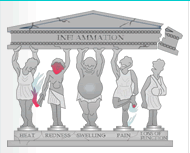Outline of research areas
Introduction for CREST Research area
Strategic sector
Creation of basic medical technologies for the prevention, diagnosis and treatment of cancer, arteriosclerotic diseases, and autoimmune disorders by the elucidation of the mechanisms underlying chronic inflammation
Research area
“Creation of basic medical technologies to clarify and control the mechanisms underlying chronic inflammation"
Outline
The purpose of this research is to elucidate the mechanisms through which inflammation becomes chronic, and to create basic technologies for the early detection, control, resolution, and reparation of chronic inflammation.
More specifically, this involves research aimed at: (1) identifying factors that induce and maintain the chronicity of inflammation by determining failure mechanisms of inflammation control; (2) clarifying the mechanisms through which specific diseases (including cancer, degenerative neurological disorders, and arteriosclerotic diseases) develop as a result of chronic inflammation, and to create basic technologies to control them; and (3) creating basic technologies that allow for the early detection and quantitative assessment of chronic inflammation. This not only involves established basic and clinical research, but also emphasizes research that sufficiently sublimes evidence-based findings for understanding higher order inflammation control mechanisms, and leads to the development of new preemptive basic medical technologies.
Research Supervisor’s Policy
Inflammation is a reaction mainly characterized by redness, fever, swelling, and pain, and has been considered a tissue repair mechanism evoked by the body in response to infections and tissue injury. It has been strongly suggested that chronic inflammation acts as a promoting factor not only in various disorders, such as cancer, arteriosclerosis, obesity, and Alzheimer disease, which increase with advancing age, but also in aging itself. However, it remains unclear why inflammatory reactions that would usually subside continue and become chronic. We do not know either through what type of mechanisms chronic inflammation causes tissue degeneration as well as various disorders. If they could be elucidated, various age-related disorders could be prevented and controlled, and it would become possible to build the foundation of “preemptive medicine necessary for an ageing society,” which enables physicians to treat illnesses not after they have begun, but to diagnose and handle them before they develop. During the beginning of the 21st century, Japan will become an aged society as yet not experienced in any country of the world. By building the foundation of such preemptive medicine, our senior citizens may be able to age in better health, and this will largely contribute to the formation of a society in which people can equally accomplish health and longevity. Furthermore, since the current treatment methods for chronic inflammation, such as steroids and immunosuppressants, nonspecificically affect immune responses, the induction of opportunistic infections become an issue. However, if the mechanisms that induce and aggravate chronic inflammation could be elucidated, it may be possible to develop more specific treatment methods that target these mechanisms.
Inflammation is usually classified into acute and chronic. Along with the recent advancements in immunology, considerable details on the development and control mechanisms of acute inflammation have emerged. However, chronic inflammation is not simply a repetition of acute inflammation, but may have qualitatively differing reactions. If this is the case, it will be difficult to understand chronic inflammation by only studying the mechanism of acute inflammation. Although it is assumed that the breakdown of inflammation control leads to the chronicity of inflammation, and furthermore to the development of various diseases, it is not known in detail what type of factors cause chronic inflammation or induce its prolongation. Furthermore, it is not clear whether the chronicity of inflammation can be suppressed through the functional control of already identified inflammation-inducing factors. It is assumed that probably dynamic reactions occur in which multiple factors interact spatiotemporally in a complex fashion.
In this research area, not only the research that elucidates the mechanisms underlying chronic inflammation or control mechanisms that make chronic inflammation subside, but also the research that elucidates the pathogenic mechanisms of diseases that are caused by chronic inflammation, as well as technological developments that visually, qualitatively, and quantitatively demonstrate the actual condition of inflammation is emphasized. In particular, in addition to the study of individual molecules, disorders, and technologies, the development of new control technologies for chronic inflammation and challenging research suggestions aimed at clarifying and controlling the pathogenesis of diseases that are caused by chronic inflammation are also anticipated.



